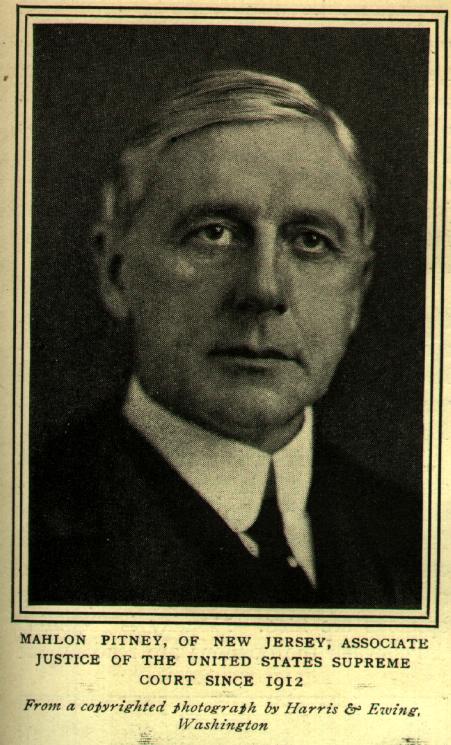| Our Highest Court | ||
"The Honorable the Supreme Court of the United States!"
Nearly every week-day during the winter months, exactly at noon, these warning words, intoned in a resonant and solemn voice, may be heard by the visitor who chances to pass the doors of the Supreme Court Chamber in the Capitol of the United States. The visitor sees that others are entering those august portals, and so makes bold to step softly inside.
If he has not waited too long, he finds himself within the chamber in time to see the nine justices of our highest court, clad in long, black robes, file slowly into the room from an antechamber at the left.
Every one within the room has arisen, and all stand respectfully at attention, while the justices take their places. Then the voice of the court crier is heard again:
"Oyez, oyez, oyez! All persons having business with the Supreme Court of the United States are admonished to draw near and give their attention, for the court is now sitting."
Then, after a slight pause:
"God save the United States and this honorable court!"
The justices seat themselves; the attorneys at the bar and visitors do likewise. The Supreme Court of the United States, generally held to be the most powerful tribunal on earth, is in session.

EDWARD DOUGLASS WHITE, OF
LOUISIANA, CHIEF JUSTICE OF THE UNITED STATES
SINCE 1910
From a copyrighted photograph by Harris
& Ewing, Washington
The opening ceremonies which the visitor sees to-day have remained unchanged for more than one hundred and twenty-five years; but that period of a century and a quarter has marked an unparalleled and continuous growth in the power and influence of the court. It was on the first Monday in February, 1790, in the city of New York, then the seat of the national government, that the Supreme Court was first organized and began its sessions. Chief justice Jay, appointed by Washington, presided.
At that first session no cases were presented to the judges. They adjourned and met on a later day, but still there was no business. After six years of comparative idleness Chief justice Jay resigned, accepting as a promotion the Governorship of the State of New York. It is worthy of note that not long ago this precedent was reversed, when justice Hughes accepted an appointment as associate justice as a promotion from the Governorship of New York.
Of the contrast between the early days and the present commanding position of

JOSEPH MCKENNA, OF CALIFORNIA,
ASSOCIATE JUSTICE OF THE UNITED STATES SUPREME
COURT SINCE 1898
From a copyrighted photograph
by Harris & Ewing, Washington
Not one of the spectators then, though gifted with the eagle eye of prophecy, could have foreseen that out of that modest assemblage of gentlemen, unheard of and unthought of among the tribunals of the earth, a court without a docket, without a case, of unknown and untried powers, and of undetermined jurisdiction, there would be developed in the course of a single century a court of whom the ancient world could present no model and the modern world no parallel; a court whose decrees, woven like, threads of gold into the priceless and imperishable fabric of our constitutional jurisprudence, would bind in the cords of love, liberty, and law the members of our great republic.
It was largely through the work of Chief Justice Marshall, greatest of the occupants of that high office, that the court grew from its modest beginning to its present transcendent importance.
Marshall strove always, and strove wisely, to extend the power and jurisdiction of the Supreme Court, and the foundation he laid was so broad and lasting that after his death the growth and extension of the structure continued without interruption. This growth

OLIVER WENDELL HOLMES, OF MASSACHUSETTS,
ASSOCIATE JUSTICE OF THE UNITED STATES SUPREME
COURT SINCE 1902
From a copyrighted photograph by Harris & Ewing,
Washington
In 1890, when the Supreme Court had been in existence for a hundred years, the amount of business handled had grown out of all proportion to the expectations of the founders. The docket was crowded with hundreds of cases, litigants were compelled
For a time after the new Circuit Court was established the Supreme Court kept up with its work; but of late years it has been falling behind again, and in many cases as much as three years has elapsed between the filing of a suit and its determination. This condition is again being relieved, however, under the energetic direction of Chief Justice White, and in February last, for the first time in a long while, the court took a recess because of lack of business. There were many cases pending, of course, but the attorneys were not ready to present them, and for a time the court experienced the novelty of waiting for the lawyers, instead of the lawyers waiting for the judges.
Nowadays the tendency of the Supreme Court is to restrict its
own jurisdiction rather than to enlarge it. Under this

WILLIS VAN DEVANTER, OF WYOMING, ASSOCIATE
JUSTICE OF THE UNITED STATES SUPREME COURT SINCE
1910

MAHLON PITNEY, OF NEW JERSEY, ASSOCIATE
JUSTICE OF THE UNITED STATES SUPREME COURT SINCE
1912
From a copyrighted photograph by Harris & Ewing,
Washington
| Our Highest Court | ||

